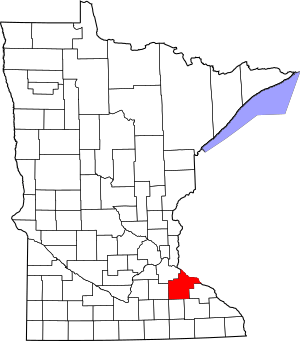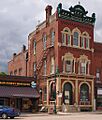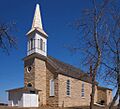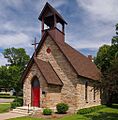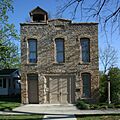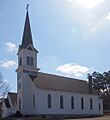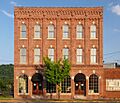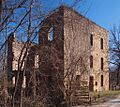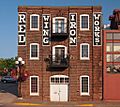National Register of Historic Places listings in Goodhue County, Minnesota facts for kids
Goodhue County, Minnesota, is home to many special places listed on the National Register of Historic Places. This list helps protect buildings, sites, and objects that are important to history. These places tell us about the past, from old farms and schools to unique buildings and natural landmarks.
There are 63 places in Goodhue County that are currently on the National Register. There were also six other sites that used to be on the list but have since been removed, often because they were moved or no longer exist.
Contents
Amazing Historic Places in Goodhue County
Homes and Farms with Stories
- Alexander P. Anderson Estate-Tower View: This unique farm, home, and lab was built in 1916. It was a place for important studies in plants, animals, medicine, and technology. Today, it's called the Anderson Center at Tower View, a place where artists can work.
- George Baslington Farmhouse: This farmhouse is a rare example of the first simple homes built in southeast Minnesota. It started as a log cabin in the 1850s, with more parts added later. It shows how early settlers lived.
- Jacob A. and Mary Finn Bringgold House: Built around 1903, this house is a great example of the Queen Anne style of architecture in Pine Island. This style often has towers, turrets, and decorative details.
- Anna and Samuel Murry Burpee House: Another beautiful Queen Anne style house from 1895 in Pine Island. It shows the popular building styles of that time.
- Harrison Miller Farmhouse: This 1869 farmhouse in Cannon Falls is special because it mixes different building styles like Greek Revival, Gothic Revival, and Italianate.
- John Miller Farmhouse: Built in the 1860s, this farmhouse shows how well farmers were doing in southeast Minnesota when they grew a lot of wheat. It was also home to a famous local farmer who became a politician.
- E.S. Hoyt House: This house, built in 1913 in Red Wing, is an example of the Prairie School style. This style is known for its horizontal lines and open spaces, designed to fit in with the flat landscape.
- James L. Lawther House: This interesting octagon house in Red Wing was built in 1857 and expanded in 1870. It belonged to a well-known local politician and real estate dealer.
- Theodore B. Sheldon House: Built in 1875, this was the home of Theodore B. Sheldon, an early settler of Red Wing. He was very important in the city's business, transportation, and community life.
- Towne-Akenson House: This Red Wing house from 1875 is one of the best examples of a wooden Italianate style home. This style was popular when Red Wing was growing fast in the 1870s.
- Fred Wallauer Farmhouse: This 1882 Italianate farmhouse shows how successful many farmers in southeast Minnesota became in the late 1800s.
- Darwin E. Yale House: This 1879 Italianate house in Cannon Falls shows the wealth and importance of a local hardware store owner.
Important Buildings and Businesses
- Bank of Pine Island, Opera House Block: This fancy building from 1895 was both a bank and an opera house. It shows how towns in southeast Minnesota grew and became more developed in the late 1800s.
- Cannon Falls Commercial Historic District: This area in Cannon Falls has many well-preserved buildings, mostly from the 1880s and 1890s. It was the main business area for a farming community.
- Chicago Great Western Depot: Built in 1906, this was one of Red Wing's two main train stations. It shows how important trains were for the area's growth.
- Ellsworth Hotel Livery Stable: This stable from around 1871 is the last remaining part of Cannon Falls' early businesses. It was where horses were kept for the hotel.
- Firemen's Hall (Cannon Falls, Minnesota): This fire station, built in 1888, shows how communities dealt with fires back then. Today, it's a museum about the history of Cannon Falls.
- Gladstone Building: A large commercial building in Red Wing, built in 1886 from local limestone. It was an important business place in the 1800s.
- Kappel Wagon Works: This building from 1875 is a rare example of Red Wing's early factories. It was known for making wagons and its strong design.
- Keystone Building (Red Wing, Minnesota): Built in 1867, this is one of Red Wing's oldest business buildings. It's a rare work by local architect Daniel C. Hill and shows the Italianate style.
- Pine Island City Hall and Fire Station: This government building from 1909 was used for many things, like city offices and the fire department. It's typical of public buildings in the region from that time.
- Red Wing City Hall: Built between 1905 and 1906, this was the first building in Red Wing made only for city government use. It features the Renaissance Revival architectural style.
- Red Wing Iron Works: This is Red Wing's oldest surviving factory building, built in 1874. It made and fixed machines, which was key to Red Wing becoming an important manufacturing city.
- Minnesota Stoneware Company: This factory complex from 1901 is the only remaining building from Minnesota's famous Red Wing Pottery industry. Now, it's a shopping mall called Pottery Place.
- Yale Hardware Store: This 1887 Italianate hardware store in Cannon Falls was a vital business for the farmers in the area.
Churches and Community Places
- Church of St. Rose of Lima: This church from 1879 and its nearby cemetery were the heart of a rural Irish immigrant community near Kenyon. It shows how Irish people settled in the area in the mid-1800s.
- Church of the Redeemer-Episcopal: Built in 1866–67, this is one of the oldest and best-preserved churches in southeast Minnesota. It shows the influence of Protestant settlers in the region.
- Cross of Christ Lutheran Church: This 1878 church near Red Wing is a good example of the churches built by Swedish American communities in southeast Minnesota.
- First Congregational Church of Zumbrota: Built in 1862, this is one of the oldest churches still standing in southeast Minnesota. It reflects how people from New England settled in many towns.
- Hauge Lutheran Church: This church, built between 1871 and 1888, was created by a Hauge Synod group. This was one of the main Lutheran groups that brought Norwegian immigrants to Goodhue County.
- Holden Lutheran Church Parsonage: This parsonage (a home for a church leader) was where Reverend Bernt Julius Muus lived from about 1861 to 1900. He was a key founder of the Norwegian Lutheran Church in the area, and St. Olaf College was started here in 1869.
- Immanuel Lutheran Church (Red Wing, Minnesota): This 1897 church represents the German American settlers in the region, who were the third-largest immigrant group after Swedes and Norwegians.
- T.B. Sheldon Memorial Auditorium: This cultural center, built in 1904, was given to the city as the first public theater in the United States. It's still used today for shows and events.
Education and Public Services
- Cannon Falls School: This school building has parts from 1893 and 1912. It shows the large schools that were built in growing towns in southeast Minnesota at the end of the 1800s.
- District No. 20 School: This excellent example of a one-room schoolhouse was built in 1889. It shows what typical education was like in rural Minnesota in the late 1800s.
- Dr. Charles Hewitt Laboratory: This office and lab from 1866 belonged to Dr. Charles N. Hewitt, who was a national leader in public health.
- Minnesota State Training School: This youth detention center, opened in 1889, is known for its strong Richardsonian Romanesque architecture. It shows Minnesota's advanced ideas about educating young people who had problems. Today, it's called the Minnesota Correctional Facility – Red Wing.
- Red Wing Waterworks: This water supply system, started in 1885, is Red Wing's oldest surviving public works facility. It provided clean water to the city.
Bridges and Roads
- Bridge No. 12: This pony truss bridge from 1908 was a common style for short bridges in the early 1900s. It shows early efforts to make bridge designs standard.
- Mendota to Wabasha Military Road: Cannon River Section: This part of a road is about 3,200 feet long and follows the path of the 1854 Mendota–Wabasha Military Road. This was some of Minnesota's first transportation infrastructure.
- Third Street Bridge (Cannon Falls, Minnesota): This bridge, built between 1909 and 1910, is a rare example of a Pennsylvania truss bridge. It was built by famous bridge builders.
- Zumbrota Covered Bridge: Built in 1869, this is the last remaining covered bridge in Minnesota. It's now a beautiful centerpiece in a public park.
Natural and Archaeological Sites
- Barn Bluff: This 343-foot-high bluff is a famous landmark on the Mississippi River. People have known about it since early European explorers came to the area.
- Bartron Site: This was a small village of the Oneota people, who lived there for a few decades between 1050 and 1200 CE. It's an important archaeological site.
- Fort Sweeney Site: This site has earthworks (mounds of earth) from around 1000 CE, located on the Cannon River. It's another important archaeological discovery.
- Spring Creek Petroglyphs: This site has ancient Native American carvings on rock, showing birds, snakes, and human figures.
Other Unique Places
- Carleton Airport: This airfield was built in 1942 by Carleton College to train pilots during World War II. It's one of the most complete War Training Service sites in Minnesota. Today, it's called Stanton Airfield.
- G.A. Carlson Lime Kiln: This lime kiln from 1882 shows the important industry of quarrying limestone and making lime in the area.
- Dammon Round Barn: This round barn from 1914 shows how farmers in the region got creative when they switched from growing wheat to dairy farming. Now, it's part of a bed and breakfast.
- E.J. Fryk Barn: This 1872 barn is an example of the small barns built when wheat farming was at its peak in southeast Minnesota.
- Florence Town Hall: This township hall from 1875 was a long-serving government building and a place for social events in the community.
- Nansen Agricultural Historic District: This large farming area has kept its traditional look and how land was used since the 1870s. It includes 190 important properties on 30 family farms.
- Oakwood Cemetery (Red Wing, Minnesota): This cemetery from 1857 shows the design ideas of landscape architect Adolph Strauch. It also has a chapel and gate from 1908 designed by Clarence H. Johnston, Sr.
- Old Frontenac Historic District: This well-preserved early resort town was started by the famous Garrard family. It shows early town planning and architecture from the Civil War era.
- Oxford Mill Ruin: These are the remains of an 1878 flour mill that burned down in 1905. It's the only standing part of a major industry in Goodhue County and shows how mills in the Cannon River Valley led to new technologies.
- Red Wing Mall Historic District: This large civic area has been important for a long time. It includes 48 significant buildings like public buildings, parks, churches, and the Red Wing Depot train station from 1905.
- Red Wing Residential Historic District: This 14-block area has homes of important residents like Eric Norelius and Frances Densmore. It shows many different architectural styles from 1855 to 1935.
- Roscoe Butter and Cheese Factory: This 1898 factory is an example of the small, rural factories that were built to support the growing dairy industry in southeast Minnesota. It's also linked to the idea of farmers working together in cooperatives.
- Vasa Historic District: This is Minnesota's most complete Swedish American settlement, started in 1853. It includes a museum in the town's original 1861 church.
Places No Longer on the List
Some places that were once on the National Register of Historic Places in Goodhue County have been removed. This usually happens if they are moved or no longer exist.
- Just C. Gronvold House: This 1873 Gothic Revival house was moved in 1991.
- Dr. Orrin I. Hall House: This 1884 house belonged to a leading doctor in southern Goodhue County. It was moved to a pioneer village in Hastings, Minnesota, in 2000.
- Kenyon Opera House: This 1890 Italianate theater was taken down in 1994.
- Julia B. Nelson House: This boardinghouse from around 1880 belonged to an educator and social activist. It was taken down in 2004.
- Roscoe Store: This 1907 department store was taken down in the late 1990s.
- Wanamingo Township Hall: This 1860 town hall was moved in 1990.
Images for kids

All content from Kiddle encyclopedia articles (including the article images and facts) can be freely used under Attribution-ShareAlike license, unless stated otherwise. Cite this article:
National Register of Historic Places listings in Goodhue County, Minnesota Facts for Kids. Kiddle Encyclopedia.

